
What’s causing the opioid crisis?
For attorneys general in 41 states, it all boils down to greedy pharmaceutical companies. For President Trump, it's the porous border with Mexico. And for certain Republican lawmakers, the culprit is too much government health care.
Opioids now kill more than 42,000 people in the US every year, a dramatic jump from 33,000 in 2015, and 8,500 in 1999. The victims are white and black, young and old, poor and rich, and even famous — including Heath Ledger, Philip Seymour Hoffman, Prince, and Tom Petty.
As the country's most alarming public health emergency in decades turns into a political football, public health experts, too, are in the midst of a heated scientific debate over how much of the addiction crisis has been driven by the decline of the working class, particularly in Appalachia and New England.
“We are trapped in our culture of hyperpartisan politics,” wrote public health professors F. Douglas Scutchfield of the University of Kentucky and C. William Keck of the Northeast Ohio Medical University in a 2017 paper examining the roots of the opioid epidemic.
"We do have tools to address the crisis," Scutchfield told BuzzFeed News. But "the politics haven't come around to give us the opportunity and the funding to really pursue them."
The political debate broadly divides those who blame demand — driven by the chemical dependence that opioids create in users, plus whatever mix of psychology and economics compels people to want drugs — and those who blame supply — the drugs’ increased availability on pharmacy shelves and suburban streets, alongside decades of declining prices.
Like most hard problems, of course, the reality is likely a combination of complex factors. Here are some of the most notable.
Big Pharma

Almost everyone agrees on how the opioid crisis began. Doctors in the 1990s honestly intended — and were educated — to help pain patients by prescribing opioid painkillers for conditions such as arthritis, back pain, and long-term injuries. Spurred by pharmaceutical industry marketing, the doctors believed the pills would not lead to addiction if prescribed in slow-release forms. So more and more people got opioids from their doctors, leading to prescription rates today about six times higher than in countries like Italy, Finland, and France.
The result is a lot of people were prescribed opioids — more than 1 in 3 Americans in 2015 — that carry dangerous risks of physical dependence if used long enough. Almost half of the people prescribed opioids for a month are still taking them a year later.
Pain patients taking long-term opioids can’t by themselves explain the increase in drug deaths, however, because most overdoses now happen to illicit drug users.
Drug cartels
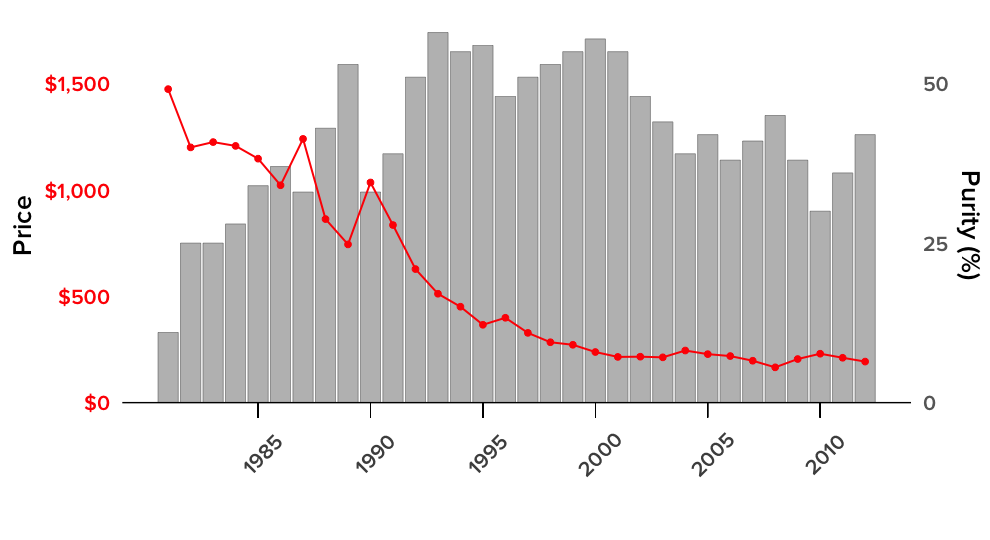
Heroin in the US is getting cheaper and more potent than ever, and overdoses from the illicit drug have increased as prices dropped and purity increased. In 1981, heroin was typically 11% pure and cost $1,477 a gram, according to Office of National Drug Control Policy (ONDCP) data. By 2012, it was 42% pure and just $193 a gram.
Behind this bump in supply were Mexican drug cartels who compete viciously for customers, now supplying 80% of US heroin, according to the Drug Enforcement Administration.
In 2013, fentanyl, a synthetic opioid 30 to 50 times more potent than heroin, arrived on the US drug scene, allowing drug dealers to stretch their supply and deliver a more potent product to their customers. Fentanyl tainting the heroin market has caused an epidemic of deadly overdoses, in numbers now surpassing those from either heroin or prescription painkillers. In cities like Baltimore, a kind of cut-down heroin called “scramble” has turned into a mixture of fentanyl, crushed painkillers, and antianxiety drugs — and has muscled the market away from more pure heroin, thought to originate in Colombia, once the leading supplier of the illicit drug to the East Coast.
Another cartel innovation described by crime reporter Sam Quinones in his book, Dreamland: The True Tale of America’s Opiate Epidemic, has been the onset of door-to-door heroin delivery services for suburban drug users.
Despair
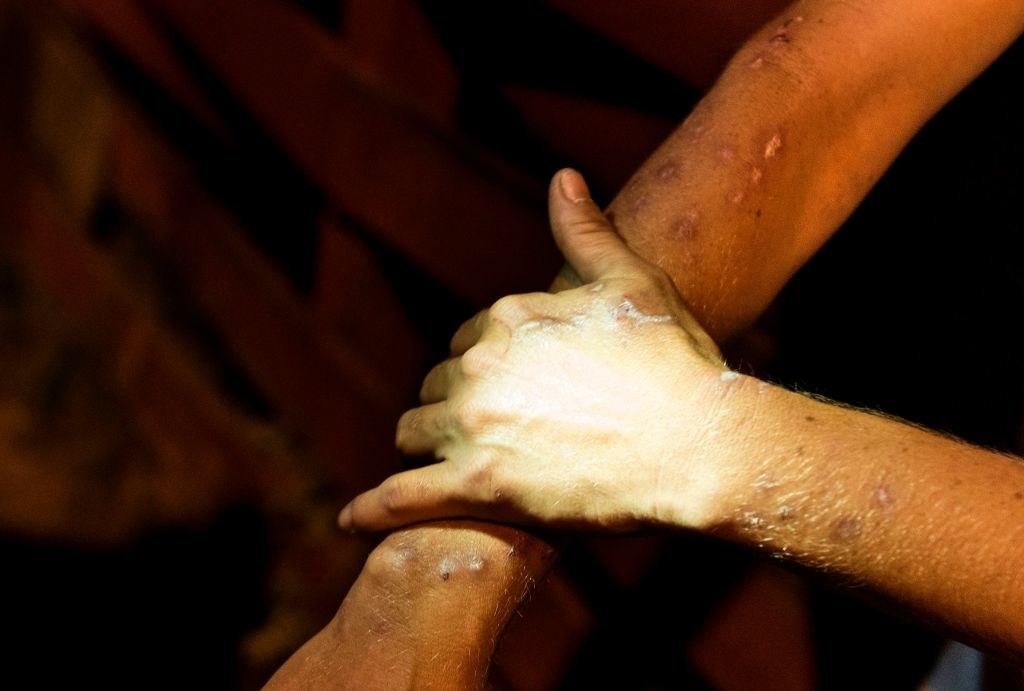
Underneath the greed of Big Pharma and Mexican cartels, the leading explanation for the surge in people using illicit opioids — whether street drugs like heroin or prescription painkiller pills “diverted” from their intended patient — stems from a sagging economy, particularly in rural parts of the US.
In an influential 2015 report, Princeton economists Anne Case and Angus Deaton described a four-decade increase in “diseases of despair” — overdoses, alcoholism, and suicides — in Appalachia and New England. In these regions, the economists suggested, the loss of industrial and other blue-collar jobs might have predisposed residents to using drugs, particularly methamphetamines and opioids.
For people who are economically and psychologically depressed, Case and Deaton wrote in a recent commentary for the Washington Post, “Opioids are like guns handed out in a suicide ward.”
Painkiller overdoses are happening disproportionately to middle-aged white people without a college degree. The surge of deaths among younger people is so bad that US life expectancy dropped for a second year in a row last year, despite elderly people living longer than ever.
The despair theory would explain this declining life expectancy among middle-aged white people, particularly set against the disenchantment in middle America that drove the 2016 presidential election. Donald Trump over-performed on votes in counties that saw the most suicides, overdoses, and alcohol deaths, one study found after the election.
In recognition of the theory’s power, the President’s Commission on Combating Drug Addiction and the Opioid Crisis, headed by former New Jersey governor Chris Christie, called for the US Agency for International Development, which typically helps struggling nations overseas, to foster economic growth in US towns hit hard by the opioid crisis instead.
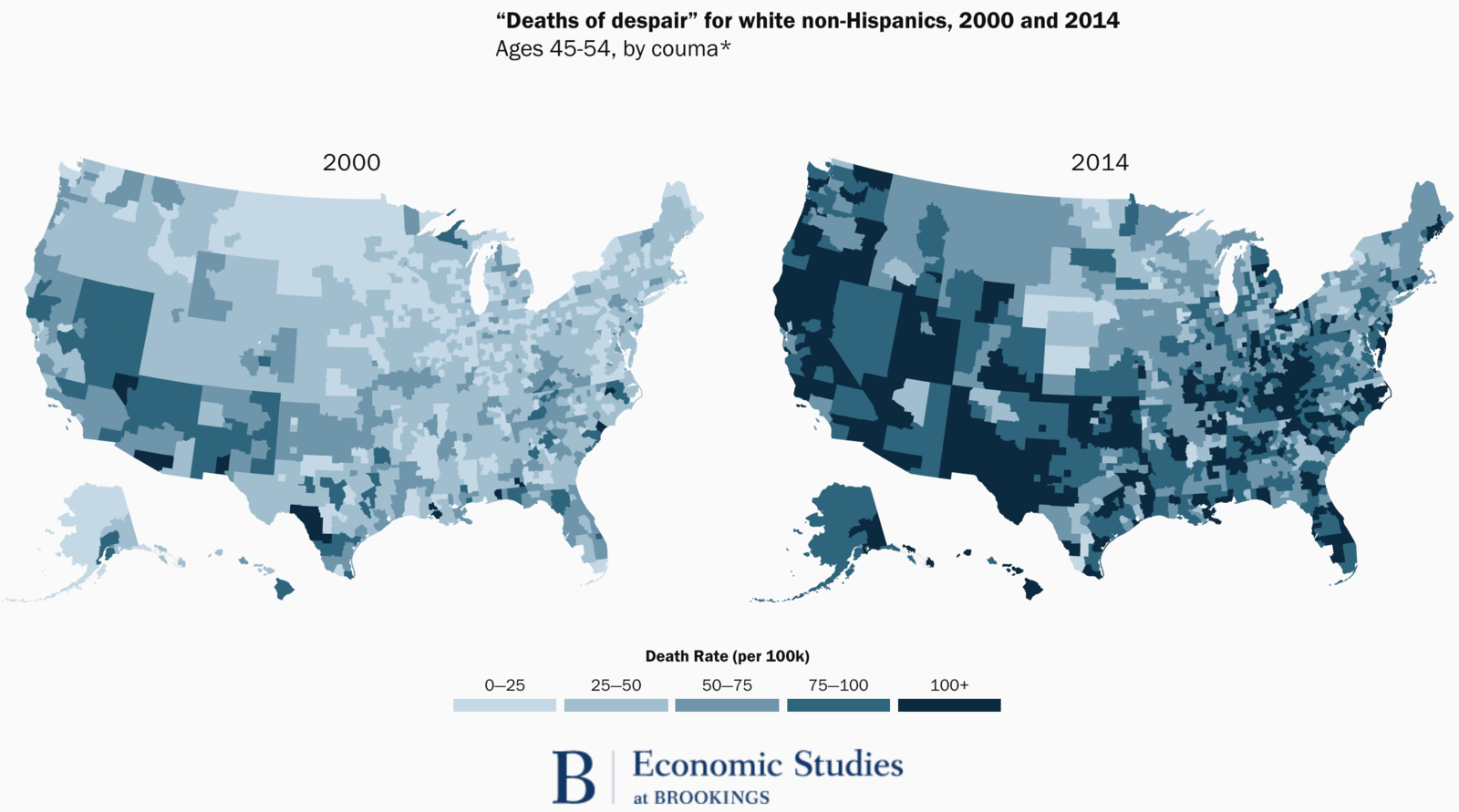
But more recently, critics have found holes in this theory. Earlier this month, a draft study from the National Bureau of Economic Research (NBER) looked at whether US counties actually saw overdoses increasing in tandem with markers of economic decline, such as job losses, higher poverty rates, declining incomes, or home price drops.
Overall, economic factors explained less than one-tenth of the overdoses, the study found. Deaths were more strongly tied to the increased availability and lower prices of opioids, pain pills, heroin, and fentanyl — simple economics — which study author Christopher Ruhm calls the “drug environment.”
The loss of industrial and other blue-collar jobs might have predisposed residents to using drugs.
Not everyone is ready to discount the diseases of despair argument. Eric Schneider of the Commonwealth Fund, a health care advocacy foundation, told BuzzFeed News the NBER study oversimplifies the despair theory, which sees a slide toward poverty as a precondition for overdose deaths, not the direct cause.
“By analogy, we might say that a drought predisposes an area to forest fires, but we don’t say that a drought causes forest fires or is the main driver of forest fires,” he said. Instead we blame weather, lightning, and dropped cigarettes as direct causes. In the case of overdoses, easy painkiller prescriptions, followed by cheaper and more deadly heroin and fentanyl, were the matches dropped on poor people who were depressed over lost jobs, higher divorce rates, and lower quality of life.
The economists who came up with the theory, Case and Deaton, echoed this criticism, calling the NBER study a “caricature” of their idea. They said it also ignores the increase in midlife deaths from alcoholism and suicide that started in the 1970s, tied to declining church attendance and marriage rates, and more children born to single mothers.
“This is about much more than economic circumstances,” they wrote in a response to questions from BuzzFeed News. “We continue to believe that the broader epidemic, including opioids, is linked to the long-term decline of working class lives.”
Government health care
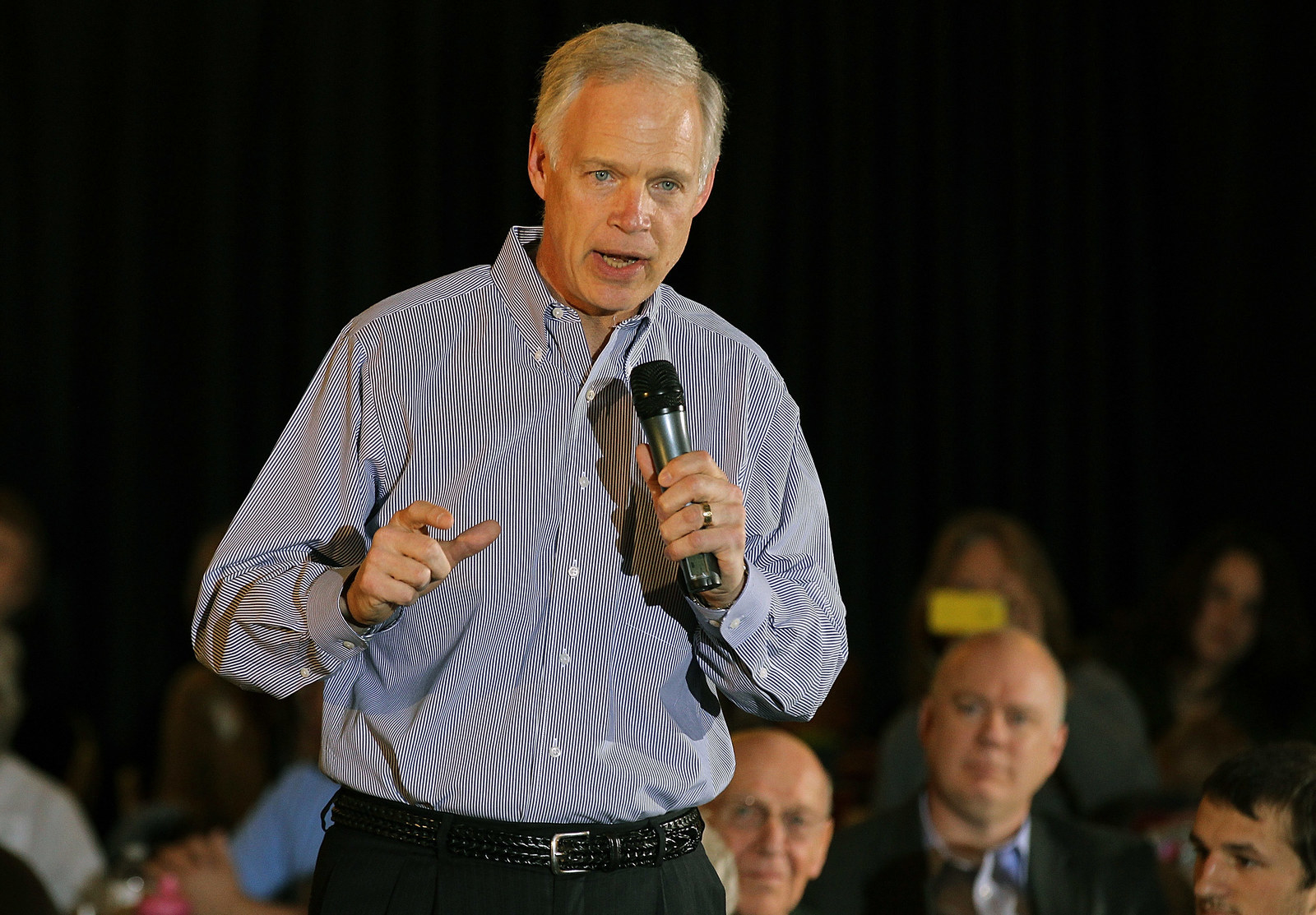
In general, politicians have fought old battles, pitting cops for the war on drugs against doctors getting people into drug treatment, rather than looking deeply into the costs of reversing four decades of economic reversal for less educated Americans.
The Medicaid theory, surfaced at two Congressional hearings earlier this month, throws opioids into yet another old battle — over Obamacare.
Sen. Ron Johnson of Wisconsin, chair of the Senate Homeland Security Committee, blamed the crisis partly on states that chose to expand Medicaid enrollments under the Affordable Care Act. He referenced a report of 10 states finding that overdose deaths rose faster in five states that accepted the Medicaid expansion than in five that did not. The report also found that hospital stays related to opioids “massively spiked” in the states that accepted the expansion.
“I’m not saying Medicaid doesn’t help many people,” Johnson said at the Jan. 17 hearing, before laying out the report’s claimed links between Medicaid and the opioid epidemic. “We ignore this aspect of the phenomenon at our own peril.”
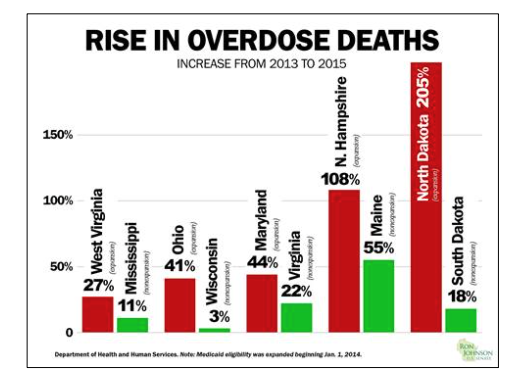
Other witnesses at the hearing, however, noted some problems with the 10-state analysis. For one thing, it left out the other 40 states and relied on percentage increases instead of raw numbers, skewing states like North Dakota, which went from 20 overdose deaths in 2013 to 61 in 2015. Most problematic, the analysis risked confusing a symptom — Medicaid spending on addiction treatment in hard-hit states — for a cause of the opioid crisis. “Correlation isn’t causation,” said David Hyman, a law professor at the Georgetown University Law Center and scholar with the conservative American Enterprise Institute and Cato Institute.
Andrew Kolodny, an addiction expert from Brandeis University, testified that Medicaid-funded prescriptions for painkillers couldn’t be blamed for the spike in heroin and fentanyl deaths. Fentanyl, as mentioned, became the leading cause of US overdoses in 2016 by killing more than 20,000 people.
“I do not believe that Medicaid expansion caused the increase in fentanyl,” Kolodny said.
On the law-and-order side, however, witnesses such as Emmanuel Tyndall, inspector general of Tennessee, described cases of Medicaid patients selling pain pills for $5 to $10 a pill, collecting more than $5,000 a year from illegal sales.
A simultaneous hearing last week in the House of Representatives oversight subcommittee, headed by Rep. Lynn Jenkins of Kansas, examined whether the federal government was doing enough about similar fraud among senior citizens on Medicare.
Pain, of all kinds

Perhaps the bleakest of bleak statistics: The most recent data on overdoses in the US, experts say, suggests that the suicide rate might be rising, too. Nationwide, the suicide rate increased 24% from 2000 to 2014, according to the CDC.
That could be partly because of the crackdown on opioid prescriptions. More than 25 million Americans have chronic pain and about 40 million experience severe pain, according to NIH surveys — almost one-quarter of the US population in all. Spurred by CDC guidelines, painkiller prescriptions have dropped by 18% since 2010. When thrust into the agony of withdrawal, some chronic pain patients have reportedly killed themselves.
Pinning an answer for the opioid crisis on any one reason might be a fool’s errand. Is it job loss that leads to depression, which leads to drug use and suicide? Or anxiety amid divorces and foreclosures leading to self-medication, bankruptcy, and more despair? Or injuries that leads to disability and job loss, followed by a dangerous prescription and a heroin use disorder?
Behind every person addicted to opioids, there’s undoubtedly a messy combination of physical, psychological, and economic factors that are almost impossible to pull apart.
“The million dollar question,” said medical epidemiologist Daniel Ciccarone of the University of California San Francisco, “is why is America in so much pain?”
